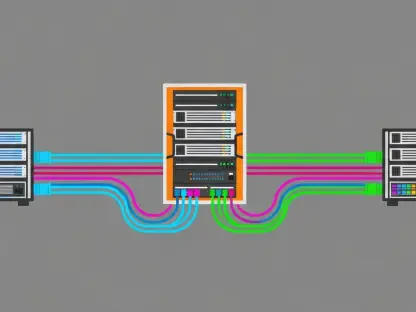In a strategic move to assist Communication Service Providers (CSPs) transitioning to cloud-native networks, Ericsson’s new Compact Packet Core presents a simplified and cost-effective solution. This comprehensive offering comprises the cloud-native Packet Core Controller (PCC) and Packet Core Gateway (PCG) network functions integrated into a single, compact rack of Ericsson’s Cloud-Native Infrastructure Solution (CNIS). The focus of this development is to streamline CSPs’ migration to cloud-native frameworks, thereby optimizing their return on investment in crucial network infrastructures.
Simplifying the Transition to Cloud-Native Networks
Pre-Configured Global Solution
Ericsson’s Compact Packet Core is designed as a global solution with pre-configured parameter settings and streamlined migration procedures, providing a more seamless transition to cloud-native environments. It promises to ease the transition while optimizing CSPs’ investment in network infrastructure. According to Monica Zethzon, Head of Solution Area Core Networks at Ericsson, this new approach targets the challenges of upgrading to cloud-native infrastructures and the introduction of 5G Core. Her assertion underlines the significance of the solution in simplifying modernization and unlocking the full potential of Ericsson’s cloud-native software.
Moreover, by pre-configuring parameter settings globally, Ericsson is addressing a major point of frustration for CSPs as they navigate the complex waters of cloud-native migration. The emphasis on a global solution ensures that the Compact Packet Core can be seamlessly implemented in various regions, reducing the need for customized deployment strategies and enabling faster, more efficient transitions. This innovation in streamlining migration processes is instrumental in supporting CSPs’ goals of launching 5G services swiftly and reliably, thereby fostering better service offerings and customer experiences.
Versatility Across Network Generations
Key features of the Compact Packet Core include its support for 4G, 5G Non-Standalone (NSA), and 5G Standalone (SA) networks. This versatility allows CSPs to meet both strategic and operational demands efficiently. A notable aspect of the Compact Packet Core is its lifecycle management service, ensuring automated network upgrades conducted by Ericsson, enabling CSPs to maintain up-to-date systems with the latest software innovations and security improvements.
The lifecycle management service provided by Ericsson is an essential component of the Compact Packet Core’s appeal. By automating network upgrades, CSPs can avoid the lengthy and often error-prone process of manual updates, ensuring their systems remain cutting-edge without disrupting service. This capability is particularly crucial as networks continue to evolve rapidly, and staying current with software innovations can significantly enhance operational performance and security. Consequently, CSPs are in a better position to address market demands and customer expectations effectively.
Enhancing Operational Efficiency
Appliance-Like Simplicity
The appliance-like simplicity of the Compact Packet Core, coupled with cloud-native benefits such as support for automation, In-Service Software Upgrades (ISSU), and Container-as-a-Service rolling upgrades (CaaS RU), provides CSPs with the flexibility to adjust networks to evolving use cases or workloads. These features offer CSPs the capability to expand services as required while reducing complexity during deployment, migration, and software upgrades.
These enhancements ensure that CSPs can quickly respond to changes in the market or shifts in technological requirements. By minimizing the technical hassle associated with upgrades and allowing for seamless integration of new functionalities, the Compact Packet Core positions CSPs to focus more on strategic growth initiatives rather than the nuts and bolts of network management. This operational agility means that CSPs can introduce new services, improve existing ones, and ensure optimal performance with minimal disruption to their ongoing activities, thereby maintaining high levels of customer satisfaction and loyalty.
Optimized Configuration
The optimized and validated configuration of the Compact Packet Core promises a significant reduction in deployment complexities, with potentially 80 percent fewer parameters to adjust during deployment. This is expected to result in a 30% reduction in both energy and hardware footprints. The solution addresses CSPs’ challenges in shifting from legacy systems, ensuring the smooth continuation of services and preserving the business logic during various stages of implementation and expansion.
Reducing the number of parameters that need adjustment during deployment means less room for error and faster implementation timelines. The resulting energy and hardware footprint reductions demonstrate a commitment to eco-efficient solutions, aligning with broader industry goals of sustainability. By lowering these footprints, CSPs can reduce operational costs and improve their corporate social responsibility profiles simultaneously. Consequently, the optimized configuration supports a holistic improvement in network operations, facilitating a smoother transition from legacy systems and enabling a more efficient and greener approach to network management.
Addressing Interoperability Challenges
Proven Packet Core Software
While leveraging Ericsson’s proven packet core software, the Compact Packet Core ensures complete interoperability across all deployment scenarios, including its own. Glen Hunt, Principal Analyst at GlobalData, highlighted the common challenges CSPs face in upgrading their cloud deployment models to benefit from a cloud-native operating model or to initiate the deployment of a 5G Core. Ericsson’s solution mitigates interoperability and integration testing hurdles by virtue of being a pre-integrated solution, thereby making the migration process less costly, complex, and time-consuming.
The critical advantage of using Ericsson’s pre-integrated solution lies in reducing the time and resources needed for extensive testing and troubleshooting. Integration challenges, often a significant barrier in transitioning to a cloud-native or 5G environment, are comprehensively addressed by a solution that is designed to work seamlessly out of the box. This savings in effort and expenditure enables CSPs to redirect resources towards more strategic initiatives such as customer acquisition, service enhancements, and exploring new revenue streams. The proven reliability of Ericsson’s packet core software further instills confidence in CSPs to adopt this solution.
Securing Commercial Contracts
This movement towards cloud-native solutions is evident as Ericsson has secured over 120 unique 5G Core or cloud-native commercial contracts by October 2024, with more than 55 live dual-mode 5G Core solution customers encompassing EPC, 5G NSA, and 5G SA live clients. The transition to 5G SA is particularly noteworthy; research from the Ericsson Mobility Report indicates that by 2030, nearly 60% of 5G subscriptions, equating to approximately 3.6 billion, will be 5G SA.
The scale of Ericsson’s commercial success signifies strong market confidence in their offerings, reflecting a broad-based commitment from CSPs to advance cloud-native and 5G Core deployments. The anticipated surge in 5G SA subscriptions aligns well with the ongoing adoption of sophisticated network technologies that promise enhanced performance, lower latency, and more flexible service models. The evidence from the Ericsson Mobility Report underscores the transformative potential of 5G SA, indicating a future where the majority of mobile subscriptions will rely on these advanced networks, driving a new wave of innovation in connectivity and digital services.
Capitalizing on Consumer Trends
Enhanced Connectivity at Events
European research shows a consumer willingness to pay a premium for enhanced connectivity and application experiences at major events such as concerts and sporting fixtures. CSPs could capitalize on this trend by leveraging 5G SA to offer differentiated connectivity services, such as reserving part of the network to guarantee quality experiences for specific users or applications.
This strategy can turn high-profile events into opportunities for generating additional revenue streams while delivering superior user experiences. By reserving parts of the network, CSPs ensure that essential services remain uninterrupted, providing VIP users with seamless connectivity regardless of the demand pressure on the regular network. Such differentiated services align with user expectations in a digital-first age, where connectivity and quality are paramount. By introducing premium offerings, CSPs can cater to tech-savvy, high-spending customers and harness the power of 5G SA to solidify market positioning and open new revenue channels.
Ericsson’s Role in 5G Development
In a strategic effort to aid Communication Service Providers (CSPs) in their shift to cloud-native networks, Ericsson introduces its new Compact Packet Core, offering a simplified and cost-effective solution. This cutting-edge offering integrates the cloud-native Packet Core Controller (PCC) and Packet Core Gateway (PCG) network functions into a single, streamlined rack of Ericsson’s Cloud-Native Infrastructure Solution (CNIS). By combining key network functions into one compact unit, Ericsson aims to make the transition to cloud-native frameworks more seamless for CSPs. With this innovative solution, CSPs can expect to optimize their return on investment in crucial network infrastructures. Additionally, the compact nature of the integration helps reduce physical space requirements, operational complexities, and associated costs. The development is a part of Ericsson’s broader strategy to support network operators in enhancing efficiency, scalability, and performance across their network infrastructures, ultimately leading to more robust and efficient cloud-native networks.









